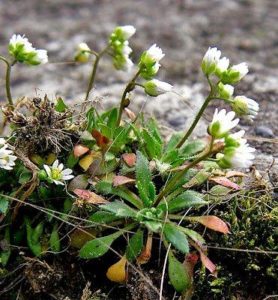Synopsis: It is National Soil Conservation Week!
Wheat survival is extremely spotty. Estimate 10-15% will be replanted. Nitrogen applications are gearing up. Corn and sweet corn planting have started: excellent uptake of Fluency Agent by growers. Sugar beet and pea plantings are underway. Soils are drying nicely. Western bean cutworm is not expected to have survived the winter. Cover crop interest remains high. Soil applied herbicides in soybeans can have significant impact on cover crops grown after wheat 16 months later (Table below). Lots of winter annual weed growth. Some growers mistaking yellow whitlow grass for Canada fleabane (picture below).
Wheat: Agricorp damage reports are increasing every day. To date, about 20% of Essex and 10% of Chatham-Kent and Lambton growers have reported damage. Consensus was 10-12% will be reseeded. Ice sheeting and water are the main culprits. The flatter the field, the greater the damage. Wheat planted after Thanksgiving to late October appears the worst (dare we say “black hole”), although in some areas early wheat is severely affected. Big wheat needs more oxygen, and can be most affected. Late wheat appears to have the best survival, but inherently has lower yield potential.
Wheat fields being kept should have something planted into the “holes” to suppress weed growth. Single cut red clover is the best in fields with small holes, and can still be broadcast in May. In bigger holes barley is suggested, it handles late planting better and maintains the rotation benefit. If the decision is to plant soybeans back into wheat fields, remember the 10% yield reduction with soys on soys, and the impact of soybean cyst nematode. Where whole fields are being taken out, corn would be the preferred crop to plant to.
Nitrogen applications are full steam ahead. Most growers were able to start Monday. The majority of growers are opting for a single application, but a number of growers are sticking to split N applications. While the calendar seems late for split N app’s, the growth of the wheat crop would support the benefit of split N.
Corn: Planting is underway on a limited basis. Soils are drying well, allowing field operations earlier than some growers expected. Lots of questions around Western Bean Cutworm. WBC is “frost intolerant”, and dies at temperatures below -7.6 C. The best guess is that WBC have not survived the winter. See Tracey Baute’s comments at https://fieldcropnews.com/2014/04/what-pests-to-expect-for-2014/
Grower uptake on Fluency Agent has been excellent. While early reports appeared to have some reluctance, pickup days told a different story. Growers are ON BOARD! There will be some neonic surveys undertaken this spring by MOE and OMAF. While this raises flags with growers, the data is needed to assess why some bee yards are impacted and others not. Please encourage growers to cooperate. St. Clair Region SCIA is hoping to have more fungicide only comparisons. If you have seed available, please contact Chad Anderson danderso@rivernet.net
Hort crops: Sugar beet, pea and sweet corn plantings are underway. Soil conditions are excellent where growers have good rotations, poor rotations are drying out much slower. Zucchini have been planted under plastic. Aspargus will be very slow this spring with cool temperatures.
Weed Control: Lots of reports of winter annual weeds in fields. An abundance of yellow whitlow grass (picture below) this spring. Some growers are confusing this with Canada fleabane. Be sure to kill annual ryegrass before it gets to the first node stage, or very high rates of glyphosate will be required.
Sandea: Read the label CAREFULLY. There are many intricacies of this herbicide. For example, Millenium asparagus has about 50% damaged (unmarketable) spears with application, while Jersey shows no injury. Permit is similar, with good crop safety on all Phaseolis (whites, kidneys, crans,etc) beans, but significant injury on Azuki beans. An excellent herbicide, but pay attention!
Cover Crops and Herbicides: Cover crops continue to be the rage, and are definitely good for the soil. However, the herbicide you use in your soybean crop can affect the cover crop grown after wheat the following year. For example, Infinity in wheat or Pursuit in soys will affect radish as a cover crop. Dr. Darren Robinson updated the group with what research has shown to date. See cover_crop_herbicide_persistence_canadian_trade_names
Research: Dr. Peter Sikkema is looking for sites with heavy field horsetail or yellow nutsedge pressure. Please contact him if you have a 0.5 acre opatch with heavy pressure of either weed in a field. Albert Tenuta is looking for sites with a history of high pythium pressure in soybeans. Again, please contact him. In all cases, the closer to Ridgetown the better…
Scouting for Pythium root rot in soybean trifold is available at the OMAF/MRA Ridgetown office 519-674-1690. Publication supported by USDA-NIFA grant and GFO funding through CAAP Program.
Next meeting:
7:15 am, May 6th, Willson Hall, Ridgetown Campus, University of Guelph
Important Dates:
July 9 and 10, 2014 Ridgetown Diagnostic Days
January 6 and 7, 2015 (Southwest Agricultural Conference) – Ridgetown
